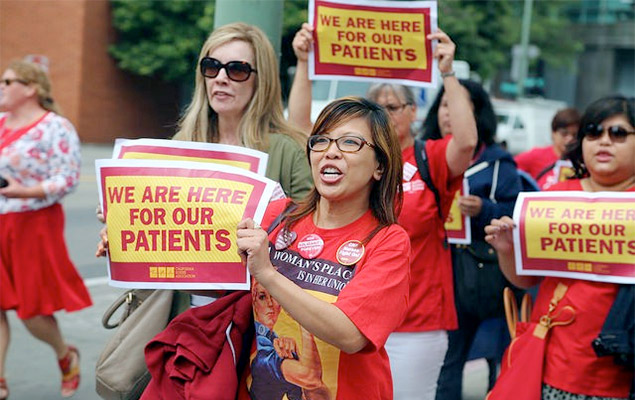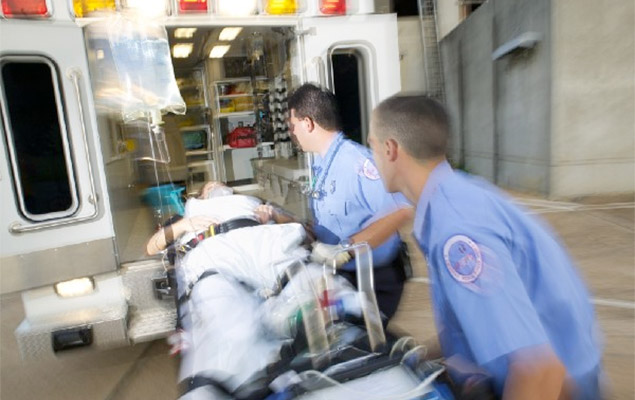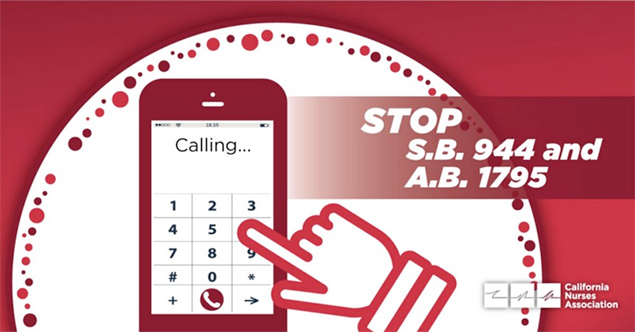Blog
Two California Bills Seek to Cut Costs By Diverting Uninsured, Medi-Cal Patients Away From Nurse Care. It’s Not Okay.

In 2013, Susan Miller, of Aurora, Illinois sued the city and fire department, arguing that paramedics thought she was drunk and advised her to “sleep it off.” In reality, she was experiencing a stroke.
When patients like Miller are brought to the emergency room, they receive a comprehensive assessment from registered nurses, who have extensive training in a broad scope of practice.
In our studies to become registered nurses, we spent countless hours poring over coursework in the biological sciences. That education and our training and expertise are how we assess which systems in the body are working or not working. We observe symptoms and changes in the patient’s condition minute by minute. We synthesize and evaluate this data, making decisions, often lightning-fast, about what kind of symptoms we’re seeing, and what resources are required to deliver the right level of care.
Paramedics, who whose training is in stabilizing patients, pre-hospital — simply do not have the same broad patient assessment skills.
Despite this fact, two new California bills — SB 944 (supported by the insurance industry) and AB 1795 (sponsored by the hospital industry) — would allow paramedics, with their limited assessment skills, to do medical clearance exams currently performed by nurses and doctors in the emergency room. As a result, they would decide whether a patient should be taken to the hospital — or not.
Certain patients could be diverted to alternate location, such as a behavioral health facility or a sobering center, where there are limited medical services. If paramedics make the wrong call, according to the legislation, they will have immunity from being held accountable.
The problems with this legislation are manifold. Patient diversions away from nurses and doctors are not about providing safe, quality care; they are about cutting costs, with an unproven, unsafe program, that could — and will — cost patients’ their lives. Let’s break down why nurses are asking the community to stand with us, as we demanding these life-threatening bills be stopped.
A Two-Tiered Standard of Care is Immoral
Take two patients: one well dressed and insured, the other living on the street with no insurance. Both are exhibiting similar symptoms, such as slurred speech. Under this legislation, would one have a greater likelihood of being transferred to the emergency room and the other to a sobering center? According to studies of California pilot projects on which these bills are modeled, the answer to that question appears to be: Yes.
It was found that 99 percent of the patients diverted from one of the for–profit, investor-owned hospitals were Medi-Cal and uninsured patients. The amount of patients with private insurance who were diverted from the ER was: zero.
“They’re creating a two-tier standard of care based on income,” said CNA Co-President Malinda Markowitz, RN.

“There’s a very slippery slope here, of judgment, of socio economic status. You take someone in Pacific Palisades who calls 911, and take an indigent person walking on the beach, and they will transfer one patient and not the other,” said Lizabeth Baker Wade, a Labor and Delivery RN from Santa Monica.
The bottom line is that that these projects have simply freed up psychiatric beds in the hospital for privately insured patients — while rerouting Medi-Cal and uninsured patients away from a hospital emergency department. And guess who benefits from the resulting cost savings? (Hint: not the diverted patients).
As patient advocates, nurses know that is disgraceful to treat the most vulnerable members of our society to a lower standard of care.
Profit Motive Behind Bills Comes at Patients’ Expense
The outward appearance of a patient picked up after a 911 call doesn’t always tell the full story. Patients may have multiple underlying medical conditions, and emergency department screening is the safest and most humane way to assure the appropriate level of care. Unfortunately, these bills are not about providing appropriate patient care to ALL patients; they are about cost savings for a variety of stakeholders.
For example, some of the alternate destination sites will directly benefit for-profit companies, including AMR, a private ambulance company. AMR has five of the aforementioned pilot projects, which would be extended under the legislation, and passage of the bill would lead to additional funding, to AMR’s benefit. A former AMR CEO is the project manager for the pilot projects.
On the insurer’s side, Anthem Blue Cross recently indicated it would reimburse ambulance companies even when they don’t take the patient to the hospital, setting up an incentive to divert patients away from the hospital.
Insurers have a direct financial incentive to push patients to alternate destinations where the amount the insurers have to reimburse the providers are significantly lower than they would be in an ER, which provides more comprehensive care. The ER also has immediate access to a hospital operating room and intensive care unit.
Private profit should never come at the expense of public good. All patients are unique, with their own medical history and conditions, and deserve a comprehensive assessment, which saves lives.
Paramedic misdiagnosis happens at significant rates
While paramedics are certainly valuable first responders, studies have shown they simply do not have the expertise of a registered nurse, based on years of scientific education and clinical experience, to independently assess 911 patients for diversion from the ER.
A study published in the January, 2017 issue of Lifeline Magazine, for example, compared assessments by paramedics of patients transported to Arrowhead Regional Medical Center in Colton, CA between April and December 2015 from the Rialto Fire Department — with assessments of the same patients by licensed ED physicians.
The study concluded there was a significant difference between the paramedic and physician assessments: the paramedics under diagnosed the severity of a patient’s condition.

Similarly, a February, 2017, editorial in the Western Journal of Emergency Medicine cited 13 research studies that found a real danger in “under-triage” (medical evaluation of a patient’s condition). The studies revealed under-triage rates as high as 32 percent in transport of patients to alternative destinations.
When a paramedic’s judgment call requires correction, it’s important to remember that for our patients, every second of wasted time could be the difference between life and death. Under the pilot projects, there have been instances where the paramedic made a decision to divert a patient away from the Emergency Room to an alternate destination site, and the patient was then denied admission to that alternate destination and sent to the ER. This results in an unacceptable delay in care for patients in emergency situations.
Paramedics Cannot Provide Primary Care — and Simultaneously Be Paramedics
Alarmingly, one of the bills, SB 944, would also allow paramedics to add primary care functions — like providing post-discharge follow-up care when a patient with a serious health condition is released from the hospital. In addition to lacking nurses’ and doctors’ extensive education, expertise and experience in providing a clinical assessment of a patient’s condition, paramedics cannot accomplish their main responsibilities of stabilizing emergent patients in pre-hospital and inter-hospital transport, while simultaneously performing additional work.
“How can paramedics handle both their existing responsibilities along with these new additional functions?” Markowitz asked, noting that one of the pilot projects had to shut down enrollment and the paramedics had to go back to their regular responsibilities because they could not provide both the pilot project services as well as meet their required 911 response times.
“This bill gives false hope to our communities that private ambulance companies and fire departments can provide both continuity of care and high quality health services in addition to their traditional EMS roles.”
It’s the wrong solution for paramedics, for communities, and for patients — especially given that there was actually an increase in the rate of hospital re-admissions for the largest group of patients enrolled in the post-discharge/congestive heart failure pilot project. In fact, the rate of hospital re-admissions was actually higher for these patients during the pilot project than prior to the initiation of the pilot.
It’s not okay to route our most vulnerable patients away from the comprehensive assessment all human beings deserve, into a program that codifies into law their likeliness of being misdiagnosed, in the name of corporate profit — with no one even held accountable.
Fight for your right to a registered nurse!
Contact your legislator today to oppose S.B. 944 & A.B. 1795.
